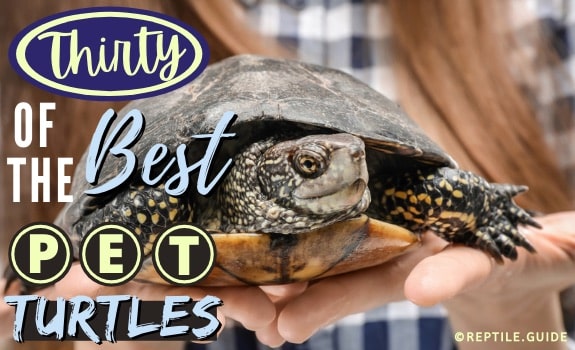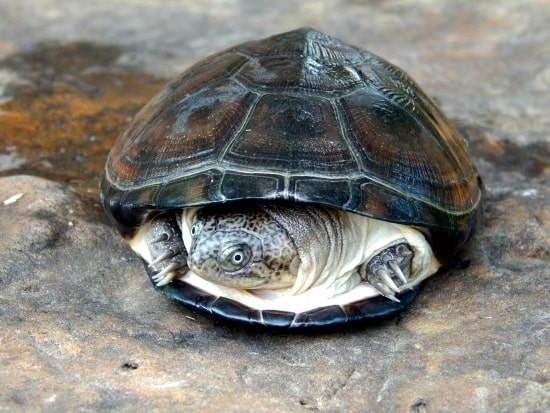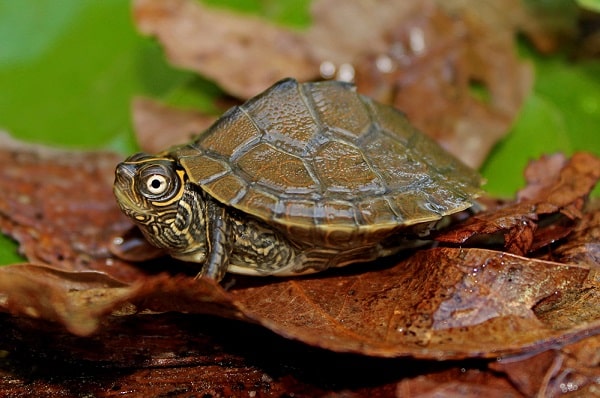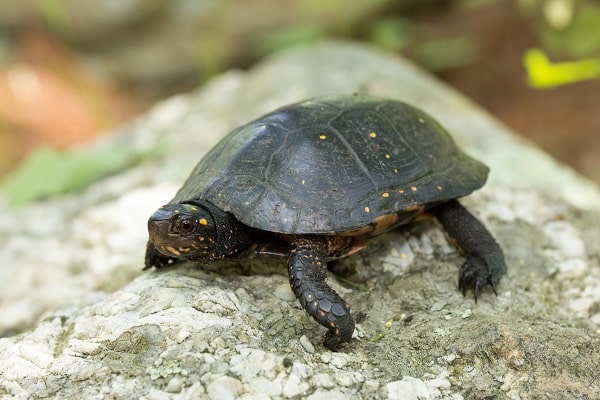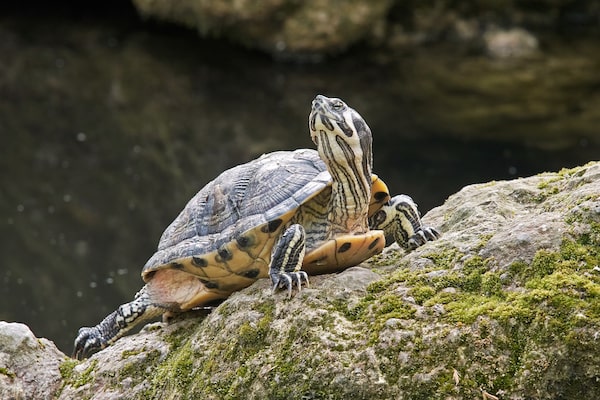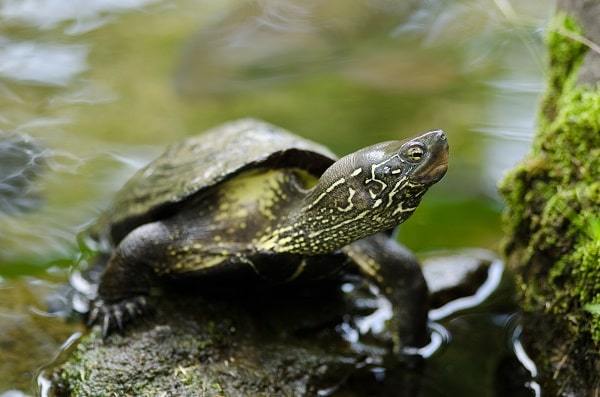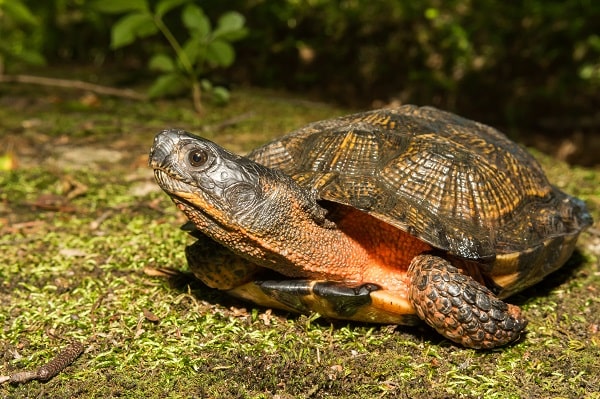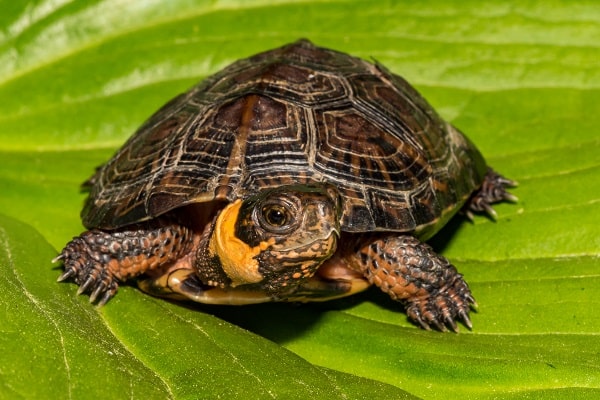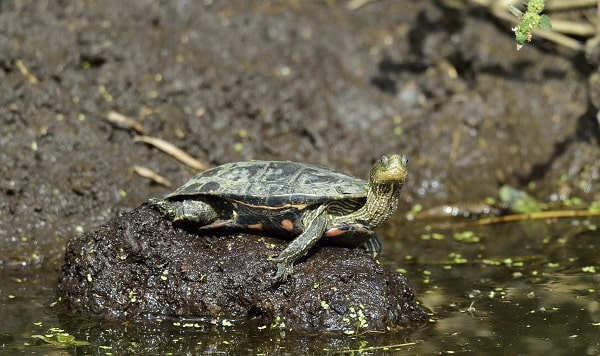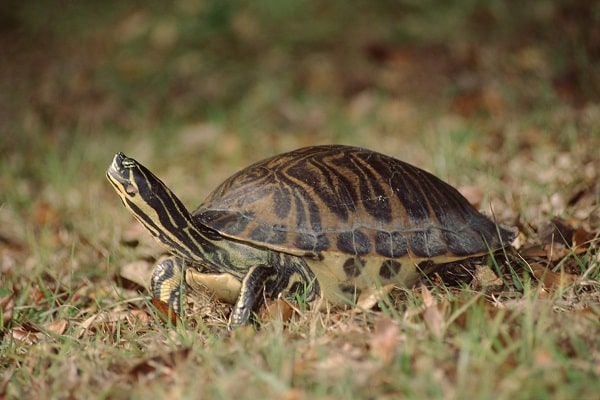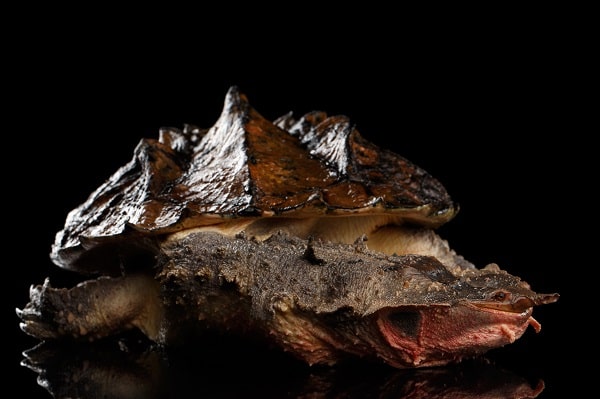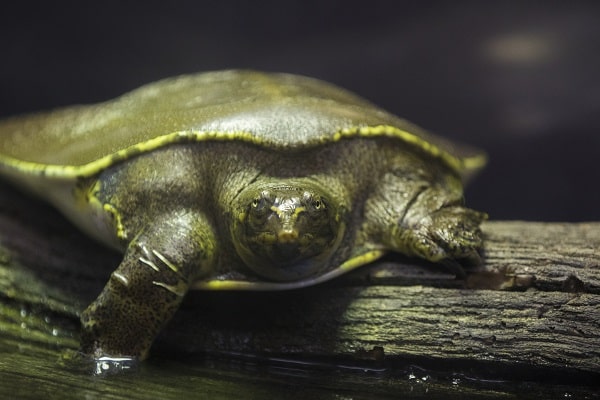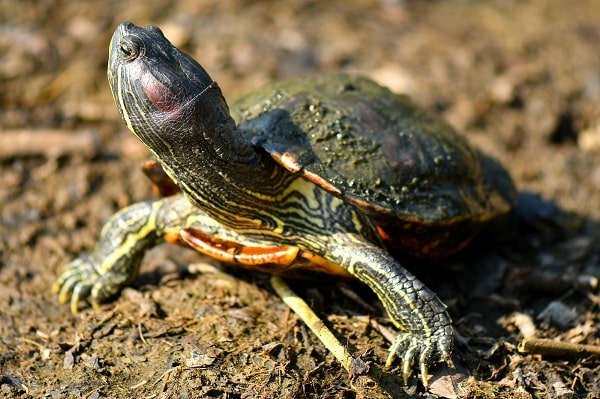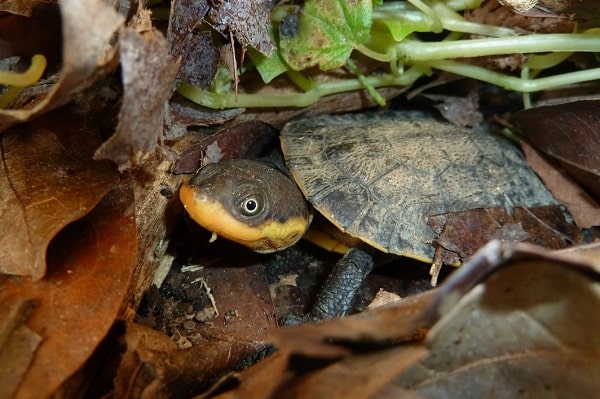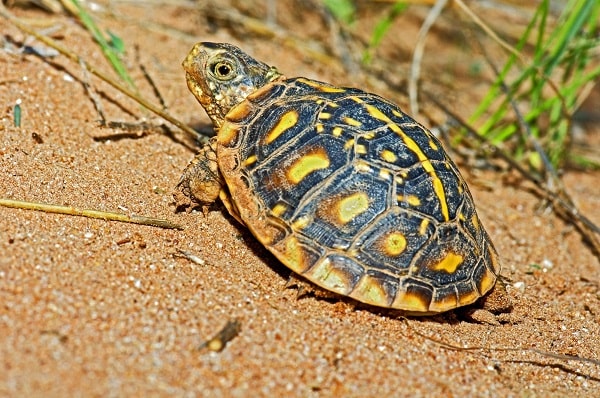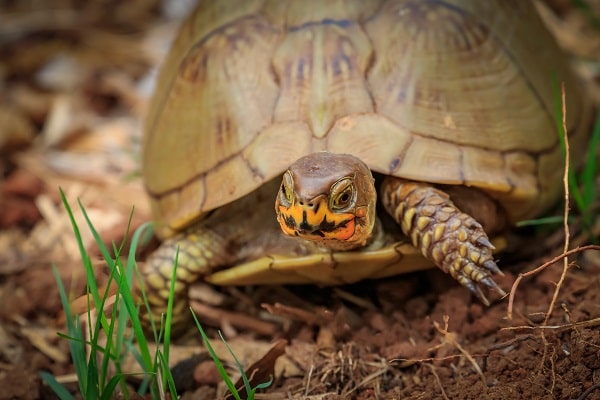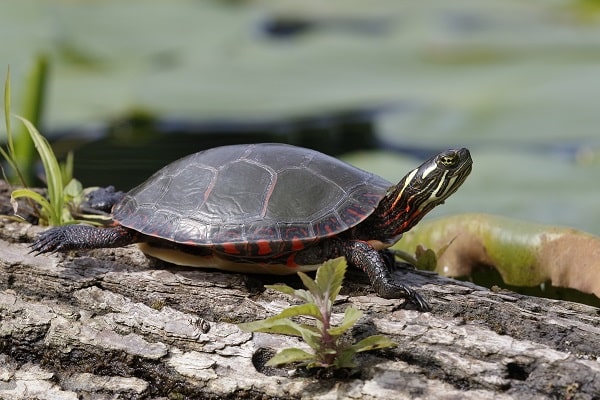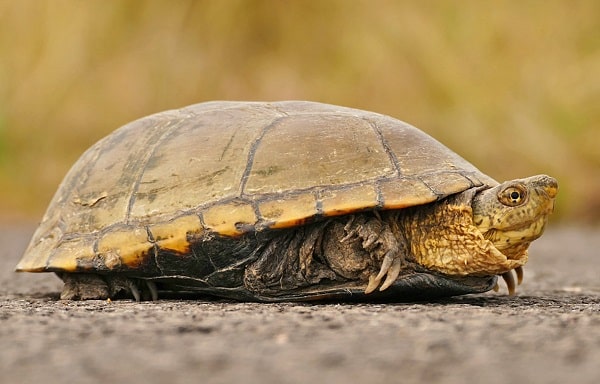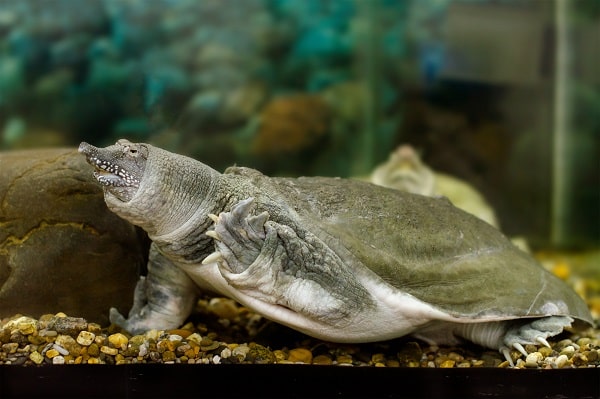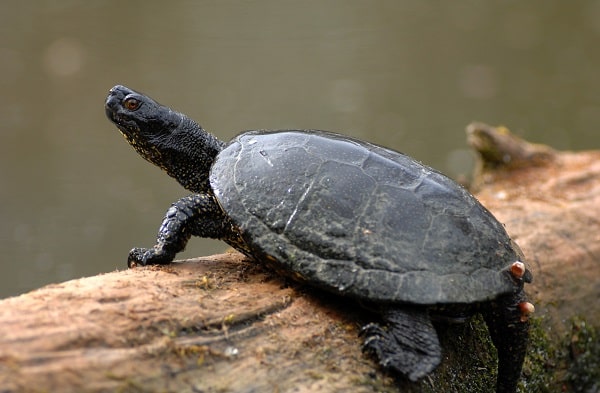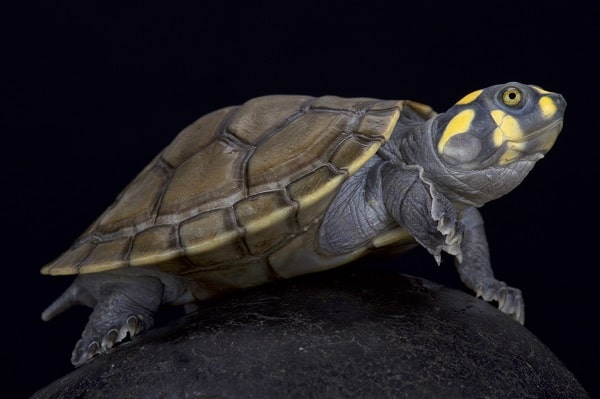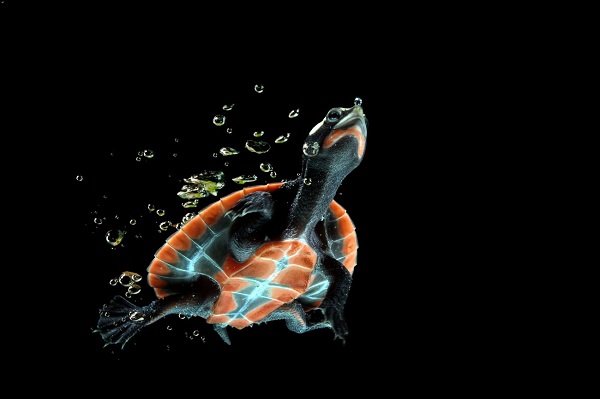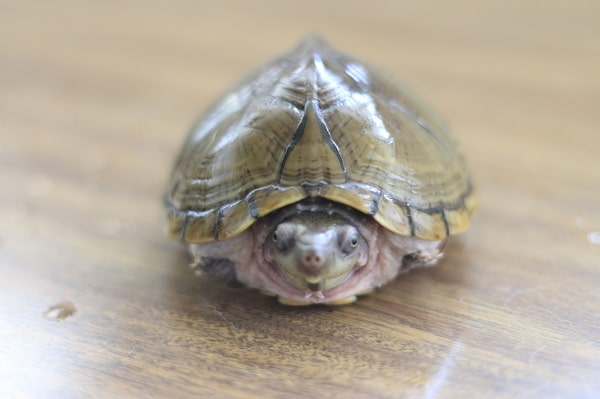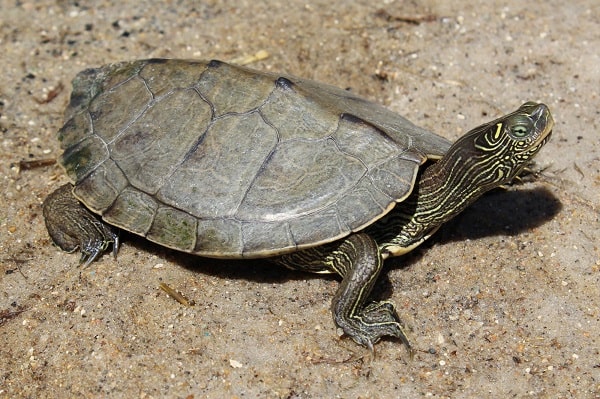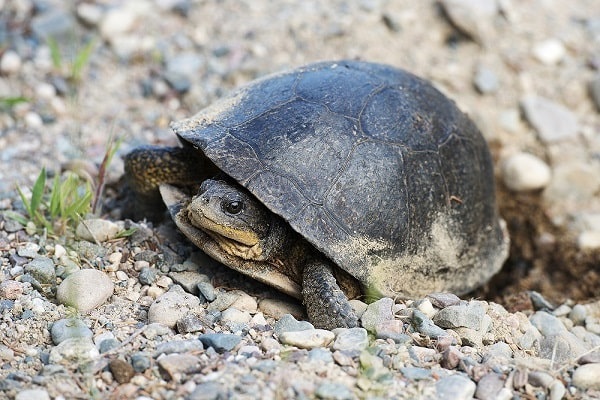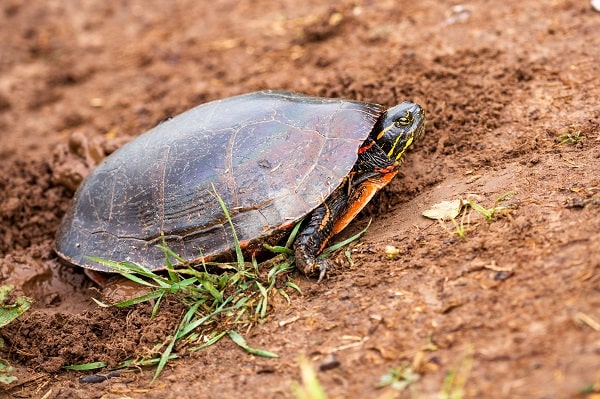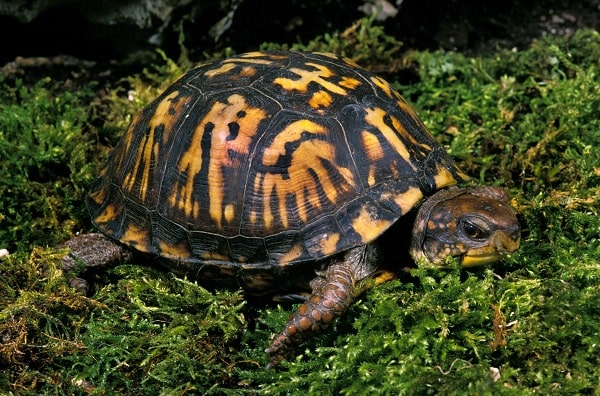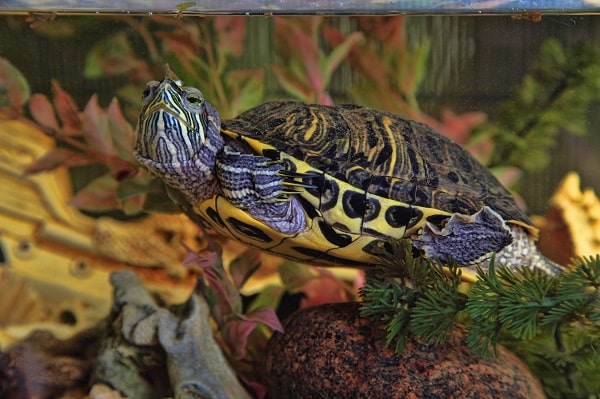So, you’ve decided you want to be a turtle owner and you don’t know what turtle is right for you. Do not fret, we’ve got you covered!
Whether you’re embarking on the journey of owning your first turtle or you’re a seasoned turtle owner, this list of 30 potential pet turtles will help you find the right one for you.
With ample options of big or small, aquatic or terrestrial, companion-seeking or solitary turtles, you’re sure to find your next life companion in this list.
Before we dive in, consider these few important considerations when reading through this list:
- How experienced are you as a turtle owner?
- How much space do you have for an aquarium, terrarium or enclosure?
- How much potential interaction do you want to have with your turtle?
- Do you want an aquatic or terrestrial turtle?
- What is your budget?
Lastly, remember that unlike dogs and cats, pet turtles – and tortoises (opens in a new tab) for that matter – can live for a very long time.
A turtle is indeed, a lifelong companion.
In This Article
African Side-Necked Turtle
The African side-necked turtle, also known as the African mud turtle, is a large turtle native to sub-Saharan Africa’s muddy river bottoms.
They are dark-colored, flat-shelled turtles that grow to be seven to twelve inches long.
These long-necked turtles were named after their adaptation to bend their neck to the side to hide their head in their shell, instead of retracting it.
They spend most of their time underwater.
They’re hardy and undemanding, although their large size dictates the need for a sizable enclosure.
Like most aquatic turtles, African side-necked turtles are omnivores with higher protein requirements as youngsters.
They’ll tolerate water temperatures in the 70°F to 75°F range, while their basking spot needs to reach 95°F.
| Facts at a Glance | |
|---|---|
| Scientific Name: | Pelomedusa subrufa |
| Price: | $40-$100 |
| Minimum Tank Size: | 75 Gallons |
| Size: | 7-12” |
| Lifespan: | 50+ Years |
Mississippi Map Turtle
The Mississippi map turtle is an attractive semi-aquatic species native to the Mississippi River and tributaries of the central United States.
Their shell is usually a monotone brown shade with ridges along the center of the carapace. Their legs and head feature intricate yellow lines and dots.
Adult Mississippi map turtles typically measure five to ten inches in length.
Their water and land-loving behaviors make this species a little trickier to care for in captivity since they’ll require both environments in their enclosure. Ingenuity and creativity are required!
They prefer their water temperature around 75°F with a basking spot that reaches 90°F.
| Facts at a Glance | |
|---|---|
| Scientific Name: | Graptemys pseudogeographica kohni |
| Price: | $20-$75 |
| Minimum Tank Size: | 75 Gallons |
| Size: | 5-10” |
| Lifespan: | 30+ Years |
Spotted Turtle 
The spotted turtle is a small, semi-aquatic turtle that lives in shallow flooded forests, meadows, bogs, marshes, and streams of the Eastern United States and Southern Canada.
Turtle keepers adore this species for their small size and attractive shell, which is dark brown or black with bright yellow spots.
Their legs and head are colored similarly, sometimes also featuring red undertones.
They’ll require a habitat set-up with roughly equal parts land and water, with the water kept shallow enough for their head to reach the surface without swimming.
Spotted turtles also thrive with lots of vegetation and cover, whether artificial or live.
The ideal basking spot for these turtles is 90°F, while the water temperature can range from 68°F to 76°F.
| Facts at a Glance | |
|---|---|
| Scientific Name: | Clemmys guttata |
| Price: | $170-$350 |
| Minimum Tank Size: | 20 Gallons (Long) |
| Size: | 3-5” |
| Lifespan: | 50+ Years |
Yellow-Bellied Slider
The yellow-bellied slider is a pond turtle native to the Southeastern United States.
Their prevalence in the wild and simple care requirements have made them common pets in captivity.
As you can probably guess, this species is named after their yellow plastron, or belly. They also have thick yellow stripes along their carapace, or top shell, legs, neck, and head.
The standard set-up with deep water, a high-powered filter, and one or more dry basking spots works excellent for this species.
They’re also perfectly suited to outdoor pond life.
They prefer their water to be a little warmer than other species, ideally 75°F to 80°F, with a dry basking spot at up to 100°F.
| Facts at a Glance | |
|---|---|
| Scientific Name: | Trachemys scripta scripta |
| Price: | $15-$75 |
| Minimum Tank Size: | 100 Gallons |
| Size: | 5-13” |
| Lifespan: | 30+ Years |
Reeve’s Turtle
The Reeve’s turtle, also known as the Chinese pond turtle, is native to shallow, slow-moving water bodies in Asia.
Reeve’s turtles’ charming personality and small size make them popular pets, even though their drab shell isn’t as bright and detailed as many other species.
These little guys aren’t the best swimmers, so the water level in their habitat should be somewhat shallow – between 1.5 to 3 times the turtle’s shell length is the safest range.
Undemanding as they are, Reeve’s turtles can be healthy and happy in a modestly sized aquarium with shallow water, a dry basking spot that reaches up to 95°F, and water temperatures between 70°F and 80°F.
| Facts at a Glance | |
|---|---|
| Scientific Name: | Mauremys reevesii |
| Price: | $35-$80 |
| Minimum Tank Size: | 55 Gallons |
| Size: | 4-9” |
| Lifespan: | 20+ Years |
Wood Turtle
The wood turtle is native to shallow, fast-moving, sandy streams in North America.
Its shell is typically darkly colored with fine, yellow lines, while its legs and neck are a striking bright red or orange.
Compared to others, this species is slow to reach maturity and, thus, has an incredibly long lifespan.
They’re also an exceptionally active type of turtle.
In the wild, they’ve been recorded moving an average of 354 feet per day. Because of this, once they reach a safe size, wood turtles should be housed in outdoor enclosures.
Aquariums simply don’t offer enough space for their active lifestyle and considerable size.
In terms of temperature, they do better in cooler temperatures below 80°F.
| Facts at a Glance | |
|---|---|
| Scientific Name: | Glyptemys insculpta |
| Price: | $200-$500 |
| Minimum Tank Size: | 5’ x 5’ |
| Size: | 5-8” |
| Lifespan: | 60+ Years |
Bog Turtle
The bog turtle is the miniature cousin of the wood turtle, belonging to the same genus. It’s the smallest turtle species native to the Eastern United States.
They are relatively rare in the wild, and there are legal protections in place that prevent their collection and interstate sales, so be sure to purchase a captive-bred individual.
This species’ unfortunate situation in the wild results in a high price tag in captivity.
Their skin and shell are dark brown, with two distinctive, large orange spots on either side of their neck.
Bog turtles are mainly terrestrial, so they will appreciate a habitat set up with roughly equivalent land and water areas.
The water should maintain a temperature of 65°F to 75°F, with a dry basking spot allowing your turtle to warm up to 90°F.
| Facts at a Glance | |
|---|---|
| Scientific Name: | Glyptemys muhlenbergii |
| Price: | $800-$1200 |
| Minimum Tank Size: | 40 Gallon |
| Size: | 3-4” |
| Lifespan: | 30+ Years |
Caspian Pond Turtle
The Caspian pond turtle, also known as the striped-neck terrapin, is a semi-aquatic turtle native to the eastern Mediterranean region.
They are highly adaptable, thriving in irrigation canals, brackish water, and virtually any permanent water body in their native range
Caspian turtles’ shells and skin are dark tan or black with yellow stripes that fade with age.
Their adaptability makes for hardy, forgiving pets in captivity.
Aside from the caveat of their large size, a Caspian pond turtle’s care is suitable for novices and keepers with moderate experience.
The water in their aquarium should be between 60°F and 82°F, and their basking spot can reach temperatures as high as 100°F.
| Facts at a Glance | |
|---|---|
| Scientific Name: | Mauremys caspica |
| Price: | $60-$200 |
| Minimum Tank Size: | 75 Gallon |
| Size: | 7-10” |
| Lifespan: | 40+ Years |
Ornate Slider
The ornate slider, also known as the Mexican slider, is very similar to red-eared sliders and yellow-bellied sliders regarding both appearance and care requirements.
Overall, they require slightly warmer temperatures, and their shell features more intricate, colorful patterning than their North American cousins.
As is true for most slider species, an ornate slider will require a minimum of a 75-gallon aquarium or, preferably, an outdoor pond.
And unlike tortoises who CAN’T swim, Ornate Slider’s require lots of deep water to dive, swim, and hide in.
Ornate sliders aren’t picky eaters, although they do prefer protein over plants, like most omnivorous turtles.
Keep their water temperature around 80°F and their dry basking spot at about 100°F, and you will have a healthy, happy Mexican slider.
| Facts at a Glance | |
|---|---|
| Scientific Name: | Trachemys ornata |
| Price: | $30-$90 |
| Minimum Tank Size: | 75 Gallon |
| Size: | 6-12” |
| Lifespan: | 50+ Years |
Peninsula Cooter
Peninsula cooters are neat little aquatic turtles native to peninsular Florida.
They live in rivers, ponds, and lakes, usually preferring to stick to slow-flowing waters.
These turtles are relatively large, capable of reaching weights of over thirty-five pounds! Because of their considerable size, adults should only be housed in huge enclosures or outdoor ponds.
Besides their size, caring for a Peninsula cooter is reasonably straightforward and similar to most other beginner-level aquatic turtle species.
They eat an omnivorous diet, requiring at least one dry basking spot that reaches the upper 80s to the lower 90s, with the water temperature in the upper 70s to lower 80s.
| Facts at a Glance | |
|---|---|
| Scientific Name: | Pseudemys peninsularis |
| Price: | $20-$40 |
| Minimum Tank Size: | 4’ x 2’ |
| Size: | 9-20” |
| Lifespan: | 30+ Years |
Mata Mata
The mata mata is perhaps one of the most interesting species of turtle that is common in captivity.
These large, sedentary turtles are native to the standing, shallow waters of the Amazon and Orinoco river basins in South America.
Their shell has evolved to resemble a piece of bark, while their head and appendages have developed jagged protrusions to take on the appearance of dead leaves.
These turtles are truly masters of disguise and camouflage!
Mata matas have particular care requirements, so they’re better suited as pets for keepers with adequate experience.
The water’s pH needs to be between 5 and 6, and the water depth kept between 8 and 10 inches.
They prefer to eat live fish and live prey only.
Given their native range, the water temperature must be kept above 80°F.
| Facts at a Glance | |
|---|---|
| Scientific Name: | Chelus fimbriata and Chelus orinocensis |
| Price: | $200-$500 |
| Minimum Tank Size: | 4’ x 4’ |
| Size: | 16-20” |
| Lifespan: | 75+ Years |
Spiny Softshell Turtle
The spiny softshell turtle is one of the largest turtle species in North America, but it is still smaller than their peninsular cousin, the Florida softshell turtle.
This species is named for its leathery, soft shell, which lacks scutes. They’re typically tan in color and covered in spots that fade with age.
In the wild, spiny softshell turtles prefer slow-moving yet well-oxygenated, clean water with sandy bottoms.
Since they rely partially on underwater breathing, they don’t tolerate stagnant water well, especially when temperatures drop.
Like other North American species, these squishy turtles do best with 70°F to 80°F water and a basking spot at 90°F.
| Facts at a Glance | |
|---|---|
| Scientific Name: | Apalone spinifera |
| Price: | $25-$300 |
| Minimum Tank Size: | 75 Gallon |
| Size: | 7-14” |
| Lifespan: | 50+ Years |
Twist-Necked Turtle
The twist-necked turtle, also known as the flat-headed turtle, is a pancake-shaped aquatic turtle native to South America.
Its shell is so flat that it must twist its neck to get its head inside!
This species’ moderate size makes it a great choice if you’re looking for a unique indoor aquarium inhabitant.
Their personality and behavior are a bit of an anomaly compared to other species. Twist-necked turtles are shy, and their natural body condition and movements may seem sickly to anyone who isn’t familiar with the species.
Their habitat should be evenly divided between dry land and shallow water. Keep the water at 75°F to 80°F, and offer them a basking spot around 90°F.
| Facts at a Glance | |
|---|---|
| Scientific Name: | Platemys platycephala |
| Price: | $75-$300 |
| Minimum Tank Size: | 55 Gallon |
| Size: | 5-7” |
| Lifespan: | 15+ Years |
Diamondback Terrapin
Diamondback terrapins are unique turtles that live in the brackish coastal marshes along the Eastern Coast of the United States.
Their reasonable size and breathtaking appearance make them highly sought-after as pets.
The shell of a diamondback terrapin is brown or gray with unique, swirly, cream-colored markings. Their skin is light gray, almost silver, with highly contrasting dark gray or black spots.
They eat shellfish and crustaceans in the wild, but they can be fed the typical (carnivorous) turtle diet in captivity.
Although they seem to survive in freshwater in captivity, most veteran terrapin keepers believe that keeping them in brackish water offers health benefits. About one tablespoon of marine salt per gallon of water is perfect.
It’s suggested to keep the water temperature in the upper 70s, with a basking spot at 90°F.
| Facts at a Glance | |
|---|---|
| Scientific Name: | Malaclemys terrapin |
| Price: | $150-$500 |
| Minimum Tank Size: | 55 Gallon |
| Size: | 5-9” |
| Lifespan: | 25+ Years |
Gibba Turtle
The gibba turtle, also known as the toadhead turtle, is a species of side-necked turtle native to South America.
In the wild, their diet consists primarily of frogs, toads, and their larvae.
Gibba turtles are relatively shy, so their habitat needs to include several caves, logs, and plants to hide amongst.
They’re highly aquatic, but they should be provided with at least one dry basking spot where the temperature reaches 95°F.
Being native to tropical regions, it’s best to keep their water temperature heated to the upper 70s.
Unlike most other turtle species, most observations have indicated that this is a primarily nocturnal species.
While they’re happy to eat day and night, they may prefer to haul out and dry up after the sun sets.
| Facts at a Glance | |
|---|---|
| Scientific Name: | Mesoclemmys gibba |
| Price: | $40-$50 |
| Minimum Tank Size: | 70 Gallon |
| Size: | 6.5-10” |
| Lifespan: | 20+ Years |
Common Snapping Turtle
With its distinctive and bony beak, the common snapping turtle is named for its most common behavior, snapping!
Although the Snapping Turtle has no teeth, its strong beak can clamp down hard to protect itself from predators, including humans and other turtles.
The common snapping turtle has a dark brown, tan or black shell, yellowish limbs and neck and a tail full of sharp ridges. Its skin is rough and bumpy.
Found across North America, in fresh or brackish water, snapping turtles prefer habitats with muddy bottoms and lots of vegetation in which to hide.
Due to their aggressive nature, they are solitary.
Like most reptiles, they have specific tank requirements. Their water temperature should be maintained at 75-78°F and their basking spot should be between 85-90°F.
| Facts at a Glance | |
|---|---|
| Scientific Name: | Chelydra serpentine |
| Price: | $25-$60 |
| Minimum Tank Size: | 2ft deep x 4ft long enclosure |
| Size: | 7.5-18” |
| Lifespan: | 18-47 years |
Ornate Box Turtle
Found in the Great Plains of the USA, the ornate box turtle is a land-dwelling species. It can be found in scattered bush vegetation and sometimes in forests.
The ornate box turtle is named for its shape. When it fully draws itself into its shell, it forms a box-like shape. Its shell is a black or dark brown color, with yellow stripes.
As pets, ornate box turtles require a lot of attention and care as they are prone to ear and eye infections and kidney problems.
Housing setups should have at least one spot of deep soil or sand for digging since they love to burrow, especially before going into hibernation.
Ensure the sides of the enclosure are high enough, as ornate box turtles also love to climb!
An ambient temperature of 80-85°F should be maintained.
| Facts at a Glance | |
|---|---|
| Scientific Name: | Terrapene ornata ornate |
| Price: | $150-$350 |
| Minimum Tank Size: | 40-gallons |
| Size: | 4-7” |
| Lifespan: |
32-40 years |
You’ll notice several entries on our list are box turtle kinds with varying housing and feeding needs.
A variety of baby box turtles is usually readily available in pet stores across the US. This makes them some of the easiest turtles to get started with.
Three-Toed Box Turtle
Named for its distinctive three-toed hind feet, the three-toed box turtle is another land-dwelling species. Native to Southcentral USA, they are often found living near water in grassy and woody habitats.
They are olive-brown in color, with bursts of yellow, red, and orange.
Three-toed box turtles have extremely effective armor clamping their upper and lower shell so tight even a piece of paper cannot be slipped through!
Three-toed box turtles have been known to be great diggers and climbers, so ensure their enclosures are at least 20” high and 10” deep. Ambient air temperature should be maintained at 80-85°F.
With increased handling and attention, three-toed box turtles have also been known to get sensitized to their owners’ voices and touch.
| Facts at a Glance | |
|---|---|
| Scientific Name: | Terrapene carolina triunguis |
| Price: | $120-$380 |
| Minimum Tank Size: | 50-gallons |
| Size: | 4.5-6” |
| Lifespan: | 30-50 years |
Midland Painted Turtle
The midland painted turtle has been known to be a great pet for beginners.
Largely diurnal, they like to spend their day swimming and basking in the sun.
Midland painted turtles are named for their coloration, as they have olive-brown to black shell colors with red and orange markings on the edges, and red and dark orange colors on the head and neck. They have broad, smooth and flat shells.
Midland painted turtles live in ponds, marshes, and slow-moving creeks.
In captivity, they require large tanks with lots of water and vegetation, and a few basking spots.
Amazingly, these turtles contain a biological “anti-freeze” which allows them to survive in freezing temperatures up to 15°F!
| Facts at a Glance | |
|---|---|
| Scientific Name: | Chrysemys picta marginata |
| Price: | $65-$100 |
| Minimum Tank Size: | 100-gallons |
| Size: | 4-12” |
| Lifespan: | 30-50 years |
Yellow Mud Turtle
The yellow mud turtle is semi-aquatic, choosing to spend approximately equal time on land and in water.
They enjoy sandy habitats and ponds with sandy bottoms.
Yellow mud turtles are small, with dark olive-colored shells and skin lined with yellow along the ridges and some yellow on the neck and chin.
Although they are low maintenance pets, many prospective pet owners are deterred by their distinct and not so pleasant smell.
As a deterrent against predators, mud turtles give off a repulsive odor when they are scared or handled.
In captivity, they require an aquarium with sufficient water and land space, maintained water temperatures between 64-68°F and basking areas at 90°F.
| Facts at a Glance | |
|---|---|
| Scientific Name: | Kinosternon flavescens flavescens |
| Price: | $150-$250 |
| Minimum Tank Size: | 40-gallons |
| Size: | 4-7” |
| Lifespan: | 10-15 years |
Chinese Softshell Turtle
The Chinese softshell turtle is as unique as they come!
Covered in a soft, olive-grey to greenish-brown, leathery skin and sporting a long, pointy, snorkel-like nose, this turtle is a top contender for the most visually appealing pet.
Native to China and Southeast Asia, these softshell turtles are aquatic animals that spend their day swimming through the waters of swamps and marshes.
In captivity, it is recommended to house them in large glass aquariums so that you can watch them swim and admire their uniqueness. Water should be maintained at 75-84°F and a basking spot at 90°F.
They are not recommended for beginners, as they are more delicate and are very shy, often resorting to scratching and biting as protection.
| Facts at a Glance | |
|---|---|
| Scientific Name: | Pelodiscus sinensis |
| Price: | $400-$600 |
| Minimum Tank Size: | 80-gallons |
| Size: | 4.5-13” |
| Lifespan: | 25+ years |
European Pond Turtle
Native to Southern and Central Europe, Northwestern Africa, and the Middle East, the European pond turtle is primarily an aquatic species living in slow-moving rivers, streams, and of course, ponds.
Adult turtles enjoy basking out in the sun for hours on end, taking frequent dips to cool off.
Although there are many color variations of the European pond turtle, they generally have a smooth, dark shell and dark skin with light specks all over.
They make great pets for beginners as they are very hardy health-wise and have been known to become quite tame, responding well to handling after being conditioned to it.
Water temperatures should be maintained at 75-85°F and basking spots at 90°F.
| Facts at a Glance | |
|---|---|
| Scientific Name: | Emys orbicularis |
| Price: | $50-$150 |
| Minimum Tank Size: | 100-gallons |
| Size: | 4.5-15” |
| Lifespan: | 15-30 years |
Yellow-Spotted River Turtle
Yellow spotted river turtles are native to South America and are found in calm waters.
Their shells are black/brown in color, and they get their name from the yellowish-orange markings on their head and neck.
They are a type of side-necked turtle, so they cannot fully retract their head into their shell.
Unlike most other turtles, yellow-spotted river turtles grow to be quite large, reaching sizes between 14 to 28”.
These turtles can also become quite heavy and thus are hard to handle. Their large size also requires increased enclosure size, with a preference for large outdoor enclosures.
The water temperature should be maintained at 72-80°F and their basking spots at 90°F.
| Facts at a Glance | |
|---|---|
| Scientific Name: | Podocnemis unifilis |
| Price: | $140-$200 |
| Minimum Tank Size: | 4” wide x 8” long x 2” deep |
| Size: | 14-28” |
| Lifespan: | 20-25 years |
Pink-Bellied Side-Neck Turtle
These sweet, docile, and easy-going turtles are a crowd favorite!
With their distinct and cheerful colors, it is mesmerizing to watch them swim, dive, and forage.
Having a grey, brown or beige shell, and a pop of pink, red or bright orange on its belly, the appropriately named pink-bellied side-neck turtle is truly a sight to see.
Native to Papua New Guinea and Australia, these aquatic turtles spend most of their time in swamps, ponds, and rivers.
Although Pink-Bellied Side-Neck Turtles are docile in nature, this species is more suitable for intermediate to experienced turtle owners who are already familiar with water filtration and is capable of providing the high water quality they need to thrive.
Water should be maintained at 66-80°F and their basking spots at 90°F.
| Facts at a Glance | |
|---|---|
| Scientific Name: | Emydura subglobosa |
| Price: | $80-$130 |
| Minimum Tank Size: | 20-gallons for 5” turtles, additional 10-gallons/inch in size |
| Size: | 5-16” |
| Lifespan: | 20-50 years |
Razor-Backed Musk Turtle
Found in the freshwater habitats, medium-to-large flowing streams, and rivers of South-Central USA, the razor-backed musk turtle is a diurnal, aquatic species.
This adorable little turtle has a light brown to orangish shell, with dark streaks. It has grey or pink skin with light brown skin dots and a hooked jaw.
Razor-backed musk turtles are generally easy to care for.
These turtles enjoy basking on logs above the water surface, so ensure you provide them with adequate, elevated basking spaces.
They also need ample hiding spots in the water, which can be provided by plants and rocks.
Water temperature should be maintained at 73-78°F and their basking spot should be at 90°F.
| Facts at a Glance | |
|---|---|
| Scientific Name: | Sternotherus carinatus |
| Price: | $50-$150 |
| Minimum Tank Size: | 40-gallons |
| Size: | 4-6” |
| Lifespan: | 20-29 years |
False Map Turtle
Like many turtles, the false map turtle is conveniently named after its unique look.
Sporting an olive, brown or black shell and skin with dark blotches, the yellow lines which run across its surface form webs that look almost like a map.
Found in large rivers across Central USA, false map turtles enjoy habitats with slower flowing currents, lots of vegetation, and ample places to bask.
In an attempt to gather as much heat as possible, the false map turtle will fully stretch out its limbs and head while basking.
They are timid turtles, and although they are unlikely to bite, they may urinate when handled. Their water temperature should be maintained at 80-85°F and their basking spot at 90°F.
| Facts at a Glance | |
|---|---|
| Scientific Name: | Graptemys pseudogeographica pseudogeographica |
| Price: | $19-$50 |
| Minimum Tank Size: | 40-gallons (males), 90-gallons (females) |
| Size: | 3.5-11” |
| Lifespan: | 30-50 years |
Common Musk Turtle
The Musk Turtle, also called the Stinkpot due to the skunk-like odor it produces when disturbed, is a small, nocturnal freshwater turtle.
Native to Eastern Canada and USA, the stinkpot can be found in ponds, lakes, and marshes that are slow-moving and have abundant vegetation.
Stinkpots have a brown or olive-colored shell and dark skin with two yellow stripes on the side of the head.
They spend the majority of their time in the water, rarely coming to bask.
They have been known to be expert climbers and so require high-walled or covered enclosures.
Water temperature should be maintained at 72-78°F and a basking spot of 90°F should also be provided.
Luckily, with frequent handling and acclimation to its owner, the stinkpot will decrease its fear reaction and stop producing odor when disturbed.
| Facts at a Glance | |
|---|---|
| Scientific Name: | Sternotherus Odoratus |
| Price: | $20-$70 |
| Minimum Tank Size: | 20-gallons |
| Size: | 2-5” |
| Lifespan: | 30-50 years |
Western Painted Turtle
The western painted turtle is native to Central North America, found in shallow waters of ponds, marshes, and slow-moving streams with muddy bottoms and lots of vegetation and spaces to bask.
They have been known to be very active during the day foraging and mating before basking in the sun to re-energize.
Western painted turtles have olive to dark green shells and skin, with yellow stripes on their legs, head, neck, and tail. They also have beautiful red markings on their underbelly.
Handling your pet should be limited to 1-2 times a week since they are not fully domesticated species.
Be warned, these little guys may bite and scratch if overly bothered!
| Facts at a Glance | |
|---|---|
| Scientific Name: | Chrysemys picta bellii |
| Price: | $50-$130 |
| Minimum Tank Size: | 20-gallons |
| Size: | 6-8” |
| Lifespan: | 30-50 years |
Eastern Box Turtle
This active, terrestrial turtle is another species in the family of box turtles.
It has a brown/black shell with yellow and orange spots, and dark skin with yellow and red markings.
Eastern box turtles can be found in moist deciduous forests and swamps.
In captivity, the eastern box turtles crave large terrariums or enclosures with lots of space to roam and exercise.
They prefer a moist substrate with lots of vegetation and must have enough space to burrow.
They thrive in temperatures between 75-80°F.
Eastern box turtles do not love to be touched, so handling should be limited.
| Facts at a Glance | |
|---|---|
| Scientific Name: | Terrapene carolina carolina |
| Price: | $270-$400 |
| Minimum Tank Size: | 75-gallons |
| Size: | 4-6” |
| Lifespan: | 25-35 years |
Red-Eared Slider
Similar in appearance to the western painted turtle, the red-eared slider turtle has an olive to dark green shell and skin, with yellow stripes on their legs, head, neck, and tail.
Most notably, they also have long red spots on the side of their head, behind their eyes.
Native to Central and Southcentral North America, the red-eared slider turtle spends its time in ponds, lakes, rivers, and wetlands.
They enjoy swimming and rarely leave the water entirely so provide them with tons of hiding spots and an easy to access basking spot at water level.
Ensure their water is kept at 76-84°F and their basking spot at 82-88°F and you will have a very happy pet!
The red-eared slider is a good beginner pet for anyone who is willing to research their care requirements and who has the budget to provide them the proper habitat setup they need to thrive.
| Facts at a Glance | |
|---|---|
| Scientific Name: | Trachemys scripta elegans |
| Price: | $25-$70 |
| Minimum Tank Size: | 55-gallons |
| Size: | 6-10” |
| Lifespan: | 30 years |
Which Is the Best Turtle for You?
Although there is no one best turtle, there is always a best fit turtle for you.
For beginners, Reptile Guide recommends the following turtle species:
- Painted turtles
- Mud turtles
- Musk turtles,
- Red-eared sliders
For owners looking for unique and visually appealing turtles, we’d recommend any of the following:
- Mata mata turtles
- Chinese softshell turtles
- Pink-bellied side-neck turtles
Regardless of which turtle is the right fit for you, always make sure to purchase captive born turtles from reputable breeders.
Never remove turtles from the wild, as this may have devastating consequences for the environment and a turtle family.
Lastly, don’t forget to check applicable laws and regulations in your area. Every country, state, and municipality has separate governing laws on exotic pet ownership.
